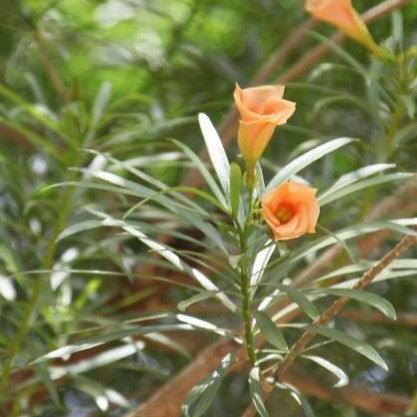-
Plant Description:
-
The trumpet flower, also known as the trumpet creeper or trumpet vine, is a fast-growing perennial vine that is native to the southeastern United States. The plant is known for its large, trumpet-shaped flowers, which can be bright orange or red and bloom from late spring to fall. The foliage is large, glossy, and green, and the plant can grow up to 40 feet long if given something to climb on. The trumpet flower is hardy in USDA hardiness zones 4-9, and can be grown in full sun or partial shade. It's propagated through the seeds, cutting or root division and it's a popular choice for covering walls, fences, and trellises in gardens.
It's important to note that trumpet creeper is considered invasive in some areas, so it should be planted with caution and kept under control.
The trumpet flower also produces a good amount of nectar, it's good for pollinator, and it can be food source for birds and butterflies.
-
Growing tips:
-
Caring for a trumpet flower vine involves providing it with the proper growing conditions and maintaining it to promote healthy growth and blooming. Here are a few tips for caring for a trumpet flower vine:
-
Sunlight: Trumpet flowers need full sun to partial shade to grow and bloom properly.
-
Soil: The plant prefers well-drained soil with a neutral to slightly acidic pH (6.0 to 7.0).
-
Watering: Water the plant regularly, keeping the soil consistently moist but not waterlogged. Once established, it can tolerate some drought.
-
Fertilizing: Fertilize the plant in spring and summer with a balanced, slow-release fertilizer or a fertilizer specifically formulated for flowering plants.
-
Pruning: Prune the plant in late winter or early spring, removing any dead or damaged wood and shaping it to control its growth. Be careful not to over prune as it can reduce the amount of blooming.
-
Support: Provide a trellis or other support for the trumpet vine to climb, as it is a vigorous grower and can reach up to 40 feet long.
-
Invasiveness: As mentionned earlier trumpet creeper can be invasive in some areas, so it's important to keep an eye on its growth and contain it if necessary.
Overall, trumpet flower is a hardy plant that can grow in a wide range of conditions, but it does require regular maintenance to keep it healthy and blooming.
.
-
Benefits:
-
Lucky Nut Peach is a variety of peach tree that is known for its small size and fruit that is said to be particularly sweet and flavorful. Some potential benefits of growing a Lucky Nut Peach tree include:
- Providing fresh, healthy fruit for consumption
- Serving as an ornamental tree in a landscape or garden setting
- Helping to attract beneficial insects and wildlife to the area.
It's worth noting that peach trees do require a certain amount of care to grow and produce fruit, such as regular watering, pruning, and protection from pests and diseases. Additionally, they require a certain amount of chill hours which is a measure of how many hours below 45F the tree is exposed to during winter, which varies depending on the cultivar.

